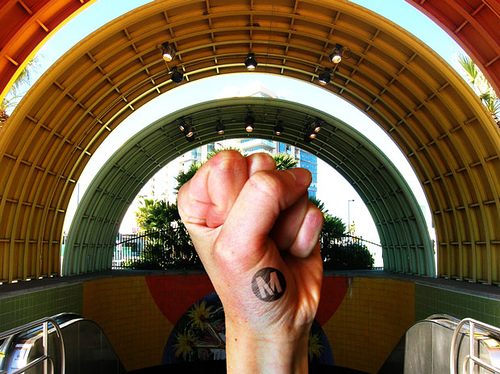When it comes to public transit in the U.S., there are certain predictable all-stars: the Metro in Washington, D.C., is convenient, efficient, and clean. The anthropomorphically nicknamed El and BART in Chicago and San Francisco are legendary. And everyone knows it’s easier to navigate New York City without a car than with one.
But what about the rest of the country? As cities big and small rethink how their residents get around, new systems are taking shape — and as gas prices and paychecks fluctuate, riders are responding in droves. While the current economic crunch is forcing many cities to hike fares and cut back on service, innovations continue, and the tracks are laid for a bright future.
Here are a few surprising places where public transit is gaining speed — steer yourself to the comments section below to leave your own nominations.
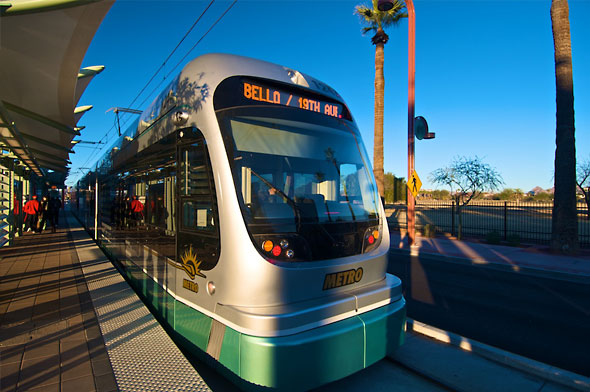 By the time I get to Phoenix, you’ll be riding.Jim JeffersPhoenix, Ariz. Pop. 1.5 million
By the time I get to Phoenix, you’ll be riding.Jim JeffersPhoenix, Ariz. Pop. 1.5 million
The desert-gobbling Arizona capital opened its first light-rail line in January with much fanfare and a few days of free rides. The 20-mile line is a modest start, but it beat early expectations, proving that even a poster child for sprawl can change its ways. Future corridors would further connect the city, America’s fifth largest. One less-than-sunny idea: The county sheriff’s “Con Rail” plan to transport inmates on city rails. And drivers are still getting used to those big moving objects: vehicles have collided with trains 22 times this year, with motorists, not Metro, taking the blame.
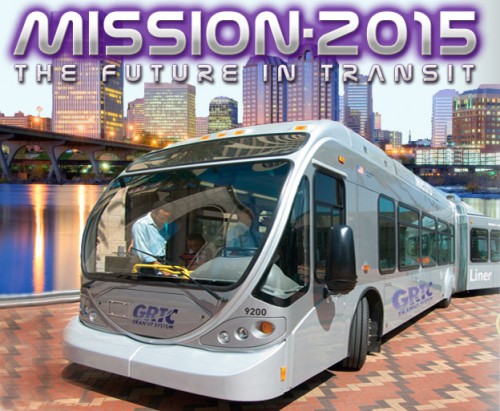 Rapid transit: the final frontier.GRTCRichmond, Va. Pop. 202,002
Rapid transit: the final frontier.GRTCRichmond, Va. Pop. 202,002
The Capital of the South is served by a century-old non-profit that runs bike-rack-equipped buses, vans, and a carpooling and ride-matching service. Honored last year by the American Public Transportation Association for its deep commitment to the community, the Greater Richmond Transit Company has taken an active role in educating residents about the joys of carless living, with initiatives including a Lunch Time Express shuttle that makes downtown stops and even a transit TV show. A plan known as Mission 2015 envisions rapid transit and a downtown transfer center — big plans for a system dubbed by CEO John Lewis as “the little engine that could.”
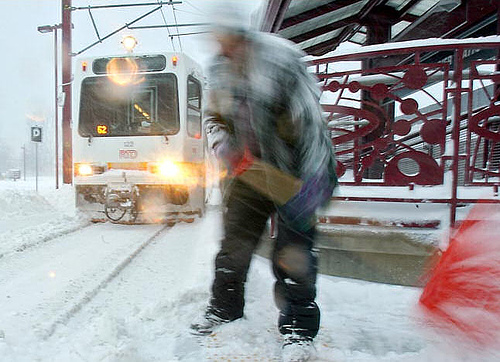 Blizzard? What’s a little blizzard?!Yokota FritzDenver, Colo. Pop. 588,349
Blizzard? What’s a little blizzard?!Yokota FritzDenver, Colo. Pop. 588,349
Denver’s mile-high sprawl is a lot easier to navigate thanks to one of the leading transit systems in the West. An established network of light rail and buses connects the city’s grid, all centered at the downtown Union Station. The voter-approved FasTracks plan will extend rail and bus lines into the suburbs, reaching into eight counties. And the Rocky Mountain Rail Authority hopes to run high-speed trains (up to 300 mph) along the oft-choked I-25 and I-70 corridors that traverse the state (though Colorado was among the states that got no love in President Obama’s national high-speed rail plan).
 A MAX bus bound for glory.busride.comSalt Lake City, Utah. Pop. 180,651
A MAX bus bound for glory.busride.comSalt Lake City, Utah. Pop. 180,651
What would you do if you expected millions of visitors to descend on your city for a couple of weeks? In Salt Lake City’s case, the answer was obvious: make it easier for them to get around. In advance of the 2002 Olympics, the city undertook several upgrades, including building a light rail system known as TRAX. The Utah Transportation Authority also runs a comprehensive bus system — which offers winter service to nearby ski areas — and a new commuter rail called FrontRunner. In fact, the city aims to build seventy miles of rail in seven years; officials are also studying the possibility of adding a downtown streetcar and a bicycle transit center. UTA actually decreased fares this year by dropping a fuel surcharge, but now budget cuts are being leveled at paratransit services, and disabled riders are none too pleased.
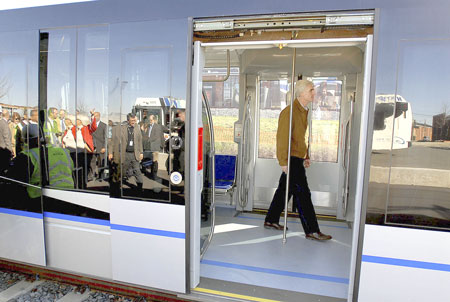 Exploring the Charlotte light rail.Charlotte ObserverCharlotte, N.C. Pop. 671,588
Exploring the Charlotte light rail.Charlotte ObserverCharlotte, N.C. Pop. 671,588
Charlotte’s light-rail line is certainly more of an up-and-comer than a well-rounded network, with its first 10-mile route opening in 2007. But what a story it’s been: Republican Mayor Pat McCrory put his career on the line for mass transit, asking this auto-loving Southern city (future home of the NASCAR Hall of Fame) to pony up nearly $500 million for the LYNX line. Sure as shootin’, voters responded. The rail line blew through 2020 ridership projects last summer, sparking new development downtown. Ridership has dropped along with the economy and gas prices since then, forcing service cuts. Still, other Southern cities have sent delegates to Charlotte to learn from this regional transit pioneer.
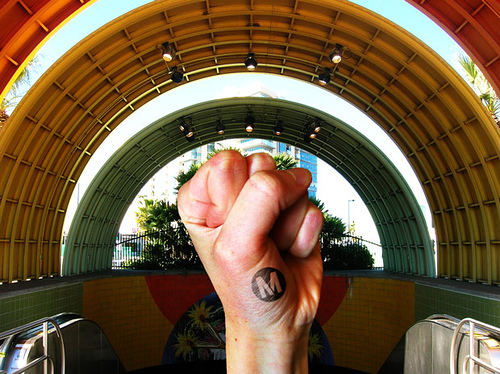 Fight the power … of smog.Fred Camino via flickrLos Angeles, Calif. Pop. 3.8 million
Fight the power … of smog.Fred Camino via flickrLos Angeles, Calif. Pop. 3.8 million
The city known for smog, sprawl, and freeways has been working for two decades to reinvent itself as a transit-friendly place, spending $11 billion on a comprehensive rail network and creating a Metro Rapid bus line that uses low floors, traffic signal priority, and limited stops to minimize travel times. The work is paying off: despite its bad rap for public transit, L.A.’s ridership ranks among the top in the nation. “We want to rethink what the city looks like,” Mayor Anthony Villaraigosa (D) has said, “to focus on a new urbanism that makes transit-oriented development and mixed-use development the future of L.A.”
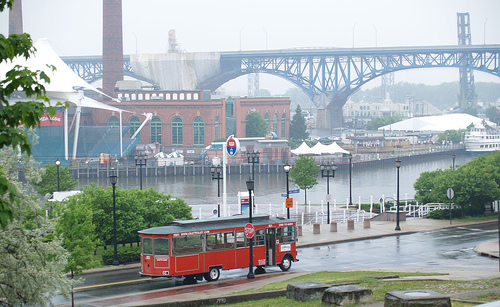 Lolly the Trolley, the ride that started it all.Crawfishpie via flickrCleveland, Ohio. Pop. 438,042
Lolly the Trolley, the ride that started it all.Crawfishpie via flickrCleveland, Ohio. Pop. 438,042
Despite financial hardships earlier this decade, the Greater Cleveland Regional Transportation Authority saw several years of rail and bus ridership growth, added “free with a smile” downtown trolleys, and was hailed as one of the nation’s best transit systems by the American Public Transportation Association in 2007. In 2008, it added a route traveled by hybrid buses. Bike racks on buses and an airport connector make it theoretically possible to get around car-free. All of which rocks! But during the last year, route cuts and fare hikes have left some customers feeling stranded.
 Riders crowd the platform at a MetroLink grand opening in 2006.Steve Patterson/Urban Review STLSt. Louis, Mo. Pop. 354,361
Riders crowd the platform at a MetroLink grand opening in 2006.Steve Patterson/Urban Review STLSt. Louis, Mo. Pop. 354,361
The Gateway City is working to reinvent itself, and its MetroLink light-rail system has played a crucial part. Ridership exceeded predictions, and advocates say the system has helped attract new shops, offices, residences, and hotels in both the Missouri and Illinois sections of the greater metro area. But after a November sales-tax referendum failed to get countywide support, the system had to raise fares and make major cuts in service. Despite the bumpy ride, experts say St. Louis is a great example of the positive impact that transit can have on development patterns.
 For iRiders, a glut of tourist attractions await.Orlando, Fla. Pop. 227,907
For iRiders, a glut of tourist attractions await.Orlando, Fla. Pop. 227,907
In a city perennially clogged with tourists, downtown traffic was a downer. So Orlando officials created a free bus rapid transit system known as LYMMO in the late 1990s. Today, they credit the system with inspiring the development of several nearby office and residential buildings and improving walkability. The city is now looking at expanding beyond its current corridors, which total about twelve miles, and replacing its “clean-diesel” buses with hybrids. In a classically American catch, the bus remains free to riders because it is subsidized by income from — wait for it — parking garages.
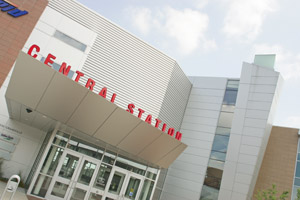 Grand Rapids Station, the nation’s first LEED-certified public transit facility.Rapid Growth MediaGrand Rapids, Mich. Pop. 193,627
Grand Rapids Station, the nation’s first LEED-certified public transit facility.Rapid Growth MediaGrand Rapids, Mich. Pop. 193,627
The transit system in Grand Rapids, known fondly as The Rapid, is like an eco-catchprase come to life. Green building? Check, in the form of a LEED-certified central terminal. Green jobs? Yep, expansion is expected to create 1,200 of them in the short-term, with about 400 being permanent. Transit-oriented development? You betcha: That LEED terminal has helped inspire $74 million of development in a three-block radius. Plus the system boasts super-friendly Midwest benefits like a shuttle in the ‘burbs that takes riders to the nearest bus stop. OK, OK — so maybe walkability is the one eco-catchphrase that hasn’t caught on yet.
This list was created by Jonathan Hiskes and Katharine Wroth. Thanks are due to the American Public Transportation Association, Environmental Defense, Planetizen, and Reconnecting America for their suggestions, information, and advice.

